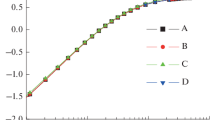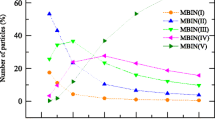Abstract
The results of calculating nuclear stopping in the semiclassical approximation for the H–Be, H–C, H–W, O–C, O–Be, and O–Al systems are presented. It was found that, in the presence of a well in the interatomic-interaction potential, an additional maximum appears in the dependence of the nuclear stopping on the energy of the bombarding particles. When using the universal potential without a well, this feature is absent. It is shown that, by means of scaling, the data obtained for systems with hydrogen are recalculated for collisions with the participation of D and T hydrogen isotopes. The results obtained are in good agreement with classical calculations, which is explained by the fact that large scattering angles make the main contribution to the nuclear stopping and the applicability criterion changes to the condition that angular momentum \(\ell \) ≫ 1.






Similar content being viewed by others
REFERENCES
H. Grahmann and S. Kalbitzer, Nucl. Instrum. Methods 132, 119 (1976). https://doi.org/10.1016/0029-554X(76)90720-5
D. Jedrejcic and U. Greife, Nucl. Instrum. Methods Phys. Res., Sect. B 428, 1 (2018). https://doi.org/10.1016/j.nimb.2018.04.039
R. Shnidman, R. M. Tapphorn, and K. N. Geller, Appl. Phys. Lett. 22, 551 (1973). https://doi.org/10.1063/1.1654504
L.G. Glazov and P. Sigmund, Nucl. Instrum. Methods Phys. Res., Sect. B 207, 240 (2003). https://doi.org/10.1016/S0168-583X(03)00461-0
Th. Krist, P. Mertens, and J. P. Biersack, Nucl. Instrum. Methods Phys. Res., Sect. B 2, 177 (1984). https://doi.org/10.1016/0168-583X(84)90183-6
A. N. Zinov’ev and P. Yu. Babenko, Tech. Phys. Lett. 46, 909 (2020). https://doi.org/10.1134/S106378502009031X
N. F. Mott and H. S. W. Massey, The Theory of Atomic Collisions (Oxford Univ. Press, Oxford, 1965).
H. S. W. Massey and C. B. O. Mohr, Proc. R. Soc. London, Ser. A 141, 434 (1933).
L. D. Landau and E. M. Lifshitz, Quantum Mechanics (Pergamon, London, 1965).
J. F. Ziegler, J. P. Biersack, and U. Littmark, The Stopping and Range of Ions in Solids (Pergamon, New York, 1985), Vol. 1.
A. N. Zinoviev and K. Nordlund, Nucl. Instrum. Methods Phys. Res., Sect. B 406, 511 (2017). https://doi.org/10.1016/j.nimb.2017.03.047
Y. R. Luo, Comprehensive Handbook of Chemical Bond Energies (CRC Press, Boca Raton, 2007).
B. Darwent, Bond Dissociation Energies in Simple Molecules (U.S. National Bureau of Standards, 1970), Iss. 31.
A. A. Radzig and B. M. Smirnov, Reference Data on Atoms, Molecules, and Ions (Springer, Berlin, 1985). https://doi.org/10.1007/978-3-642-82048-9
B. P. Nikol’skii, Handbook of Chemist (Khimiya, Leningrad, 1966), Vol. 1 [in Russian].
NIST data base. https://webbook.nist.gov/chemistry/
J. Linchard, V. Nielsen, and M. Scharff, Mat.-Fys. Medd. – K. Dan. Vidensk. Selsk. 36, 1 (1968).
Funding
This work was carried out within the framework of a state assignment of the Ministry of Education and Science of the Russian Federation to the Ioffe Institute, Russian Academy of Sciences.
Author information
Authors and Affiliations
Corresponding author
Ethics declarations
The authors declare that they have no conflicts of interest.
APPENDIX
APPENDIX
Derivation of the Formula for the Transport Section Q tr
Here, θ is the scattering angle in the center of mass system and f(θ) is the scattering amplitude, which, without any assumptions and simplifications, can be written as
where \({{\delta }_{\ell }}\) is the scattering phase and \({{\delta }_{\ell }}\) in the semiclassical approximation is determined by the expression
For a term with unity, we obtain a term corresponding to the elastic-scattering cross section. For a member with cosθ, we use the properties of the Legendre polynomials:
In the product of two sums, due to the orthogonality of the Legendre polynomials in the sum over \(\ell \), there will be contributions from terms with m = \(\ell \) – 1 and m = \(\ell \) + 1.
Consider the term with m = \(\ell \) – 1.
Consider the term with m = \(\ell \) + 1.
If we take the integral, then the terms with the index \(\ell \) and terms with the indices \(\ell \) – 2 and \(\ell \) + 2 contribute to the corresponding terms of the sum when \(\ell \) = \(\ell \) – 2 and \(\ell \) = \(\ell \) + 2.
Let us rewrite the sum:
Given the normalization of the Legendre polynomials,
we obtain
At \(\ell \) = 0, the term in the second sum does not contribute. Shifting the summation index, we obtain
Splitting the first sum into two sums with weights \(\ell \) and \(\ell \) + 1 and shifting the summation in the first term by 1, we have
Combining the amounts, we obtain
or
Having carried out trigonometric transformations, we obtain the Mott–Massey formula [7]:
Rights and permissions
About this article
Cite this article
Babenko, P.Y., Zinoviev, A.N. Calculation of Nuclear Stopping in the Semiclassical Approximation. Tech. Phys. 67, 1–6 (2022). https://doi.org/10.1134/S1063784222010029
Received:
Revised:
Accepted:
Published:
Issue Date:
DOI: https://doi.org/10.1134/S1063784222010029




